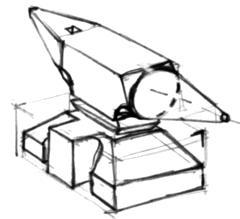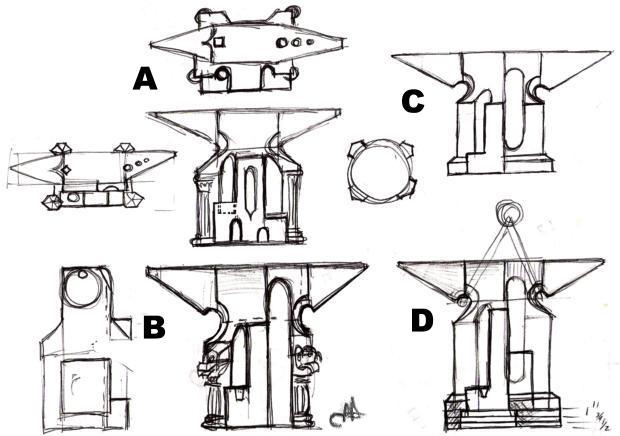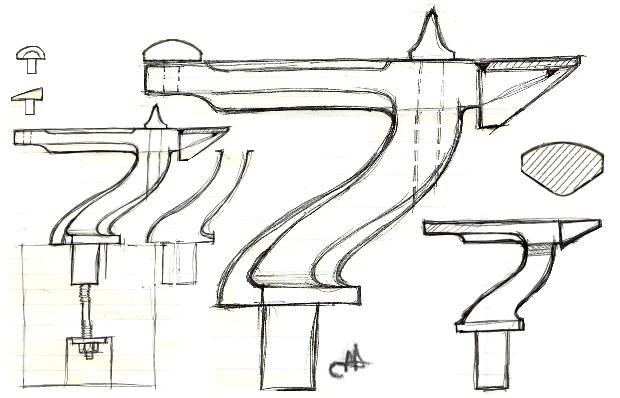I have been drawing and designing anvils of one form or the other for almost 40 years.
My early designs were for
I-beam
anvils and similar fabrications.
I was lucky to have found a fellow that had one and realized how worthless they were before wasting my time with them.
Later our family shop was involved in building heavy machinery and I found that working with plate as heavy as 8" (200mm) was not a problem and THAT opened many possibilities.
In more recent years I have had the chance to travel and to study anvils of almost every maker and style throughout history.
The following is the result of that lifetime of study.
 ABOVE:
ABOVE: Two clean methods of making solid steel anvils that could be used in production.
The German style base can be 100% flame cut and the top flame cut and machined.
Welding needs a spacer to add some waist and produce 100% penetration.
Originaly the design used a piece of square on diagonal OR a cross shaped piece doing the same.
Ideally this design would be welded by the Thermit process but it has never been reportedly applied to anvils.
The drawing below uses a thick plate with chamfers to create a pair of heavy welds without 100% penetration but as strong as other welded anvils.
The welded horn with
milled hardy hole is a completely original design that solves the problem on broaching a hardy hole.
Deep broaching is difficult and the cutter expensive.
Milling is a common task producing an accurate hole to any desired dimension.

 Machining a perfect conical horn
Machining a perfect conical horn can be done efficiently starting from a flame cut blank to reduce the bulk of material.
To do so on a full anvil top requires an angle fixture on a large turret lathe or similar machine.
If shaped by hand it helps to carefully cut an octagon as shown at right.
These 2 piece designs assume drilling and broaching or drilling and hand working a square hardie hole.
If hand worked the hole should be counter bored from the bottom so that only an inch at the top must be worked square by hand.
See
Stake Plates and Bolsters for details of making square holes.

An anvil body with arched "church windows" can be built up producing nearly 100% weld under a tool steel top plate.
This reduces the need for a full width thickness of body plate.
Welding and finishing the arches is a lot of work but produces a classic base to build upon.
The arches greatly reduce the amount of open area under the plate so that the welds are near the face and center of the body.
At left is a sloped side such as on old German style anvils.
 ABOVE:
ABOVE: The method used by
Daniel Boettger with the alloy top plate extending from anvil tip to tip.
Done properly 100% of the horn tips are top plate material.
Under the plates is filled in by a variety of methods building up the horn to nearly solid (see below).
Decorative molding base's can be built with pieces of heavy plate or bar.
Different stock or forged sections could be welded up in a variety of ways to produce effects from architectural moldings to rough stone or even dragon claws.
 RIGHT:
RIGHT: Horn fill in detail using laminated plate welded all around.
Note the end of the horn made entirely from the thick (1" - 24mm) top plate and the fill around a hardy hole.
FAR RIGHT: An early style side hardie hole as part of a laminated church window plate.
 MEGA ANVILS:
MEGA ANVILS: Most anvils over 400 or 500 pounds (180 to 225 kg) are ridiculously large.
They take up too much space in the shop and are cumbersome to maneuver around.
These "mega" anvils are ridiculously heavy but take up no more space than a 500 pound anvil.
The weight is in the integral base making them a virtual imovable object.
These anvils would weigh in at about a ton.
These mega anvils are designed to be functional works of art.
They are made of huge slabs of steel with built up additions of stylish upsetting blocks at various levels and a decorated base.
- Built up of 6" and 8" plate slabs and blocks. Corinthian columns on the four corners.
- Similar to A with gargoyle heads atop the columns.
- Round base with cut out and radiused to match additions. A clean modernistic style.
- Same as above with lifting fixture and nesting spacer plates for height adjustment.
 Anvil of Creation:
Anvil of Creation:
Another "mega anvil" designed to symbolize its coming from the Earth.
The base built up of hex bar stock to look like rock crystals.
Large 3" or 4" pieces of hex stock form upsetting blocks at different levels.
Colored "crystals" made from polished brass and stainless hex.
They "grow" out of an amagamated mess of scrap held together by porus sputter ball welds finished to look like foaming lava.
 Super Style:
Super Style:
This design uses the standard anvil components and bits of various designers ideas carried to the maximum.
While ultra stylistic it is not "cartoony". The result is entirely original.
The pyramidial base is reminisant of the early English anvils that had bases much wider than the face.
The heavy under body chamfers are lines the German designers used but not to this extent.
The whole is symetrical as possible with both square and round horns.
It is also possible to manufacture by flame cutting and welding as a two piece anvil.
 Armourer's Stake Anvil:
Armourer's Stake Anvil:
This design is based on
Eric Thing's simple heavy duty stake but has a little more style and support.
It also has two hardie holes for stakes and hardie tools and a funnel horn like a blow horn stake.
The stud and nut hold down is an add on option.
This can be a forged two piece (with funnel), a three piece (including funnel) or multipiece design.
The original idea was to use RR-rail for the top and torch cut heavy plate for the shank and stake.
CREDIT and USE: While these designs, many 100% original, are being published here for the public to take from them what they will, PLEASE note that these ARE original designs.
If you wish to use these designs commercially or in quantities other than for personal use then lets talk. I can carve 3D patterns as well.
I am very reasonable about such things unless someone steals them and claims they are their design.
If anvil design was easy there would be many beautiful anvils on the market.
Instead, during the last few decades, most original patterns have been styleless and some down right ugly even when copying traditional designs.
References and Links









 Anvil of Creation:
Anvil of Creation:



städ, incus, aambeeld, batente